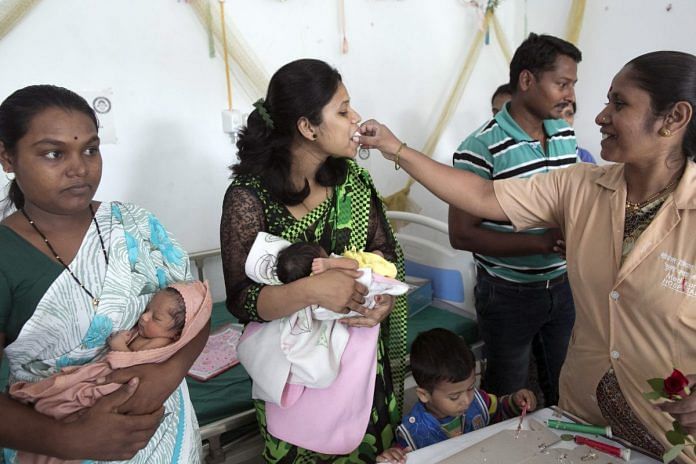Fertility reduction and a gender-balanced population often appear as conflicting objectives, as targeting one may worsen the other.
Cheap technology for prenatal sex determination has allowed parents that prefer sons over daughters to selectively abort girls, thereby increasing the male-female sex ratio at birth in Asia, Eastern Europe, and among Asian diasporas in North America and Western Europe. For every female birth, 1.18 and 1.11 boys were born in China (in 2010) and in India (in 2006–2008), respectively. Relative to the “natural” sex ratio at birth (≈ 1.05), these numbers reflect a substantial demographic imbalance.
Bans on sex selection are difficult to implement since abortion and ultrasound scans are, typically, not illegal in these countries. As a result, existing regulations have been largely unsuccessful and policymakers have turned to financial incentives instead. However, programs that seek to decrease the sex ratio by incentivizing parents to have more girls or, more generally, by improving the relative value of girls, may lead to higher fertility if parents respond by increasing the number of daughters without decreasing the number of sons equally. This may happen if sons and daughters are imperfect substitutes or if parents desire a minimum number of sons.
Fertility reduction and a gender-balanced population often appear as conflicting objectives, as targeting one may worsen the other. In fact, fertility decline has been shown to be a cause of the rising sex ratios at birth, with technology playing a facilitating role. Figure 1 displays the inverse trends in fertility and the child sex ratio for India and China.

Devi Rupak is a conditional cash transfer program announced in 2002 by Haryana. Devi Rupak seeks to decrease both fertility and the sex ratio at birth by rewarding couples that have either one child or two daughters and no sons. The benefit for two girls or one boy is the same and smaller than the benefit for one girl. These payments are disbursed on a monthly basis for a period of 20 years and their magnitude is substantial—the monthly benefit for couples whose only child is a girl is approximately half of Haryana’s per capita monthly consumption expenditure.
I find that Devi Rupak increases the probability that a couple has only one child by 0.6 to 1 percentage points. However, this fertility response is primarily driven by a 0.4 to 1 percentage points or a 5 to 11 percent increase in the probability that a couple has only one boy, from a baseline probability of 8.7 percent. Despite one girl being the most remunerative child composition, there is no increase in the share of couples with one daughter and no sons in the overall sample. There is a small increase in the likelihood that a couple has only two girls, but it is not consistently significant.
Most strikingly, Devi Rupak also increases the sex ratio at first birth by 1 to 2.3 percent. While previous literature has found no evidence of sex selection for first births in India (Bhalotra and Cochrane 2010), Devi Rupak induces couples to make decisions about sex selection at first parity as it only offers benefits for either one child or two girls. My results on birth spacing reinforce that Devi Rupak increases sex selection for the first birth.
Although Devi Rupak was implemented in only one Indian state, it is representative of the more recent programs along several dimensions.
The one-boy incentives being offered by Devi Rupak are sufficient to make couples forgo unwanted daughters, but the higher incentive for one-girl is insufficient to forgo a son. The demand for sons is, thus, less price-elastic than the demand for daughters in this context, where sons are perceived as “better-quality” children.
In terms of policy implications, my results suggest that removing the one boy option from Devi Rupak will avoid the unintended increase in the sex ratio at first birth, but may also adversely affect the fertility decline. Ultimately, the fertility-sex ratio trade-off will persist unless son preference weakens. As previously mentioned, the underlying reasons behind son preference could be many. If discrimination against girls is primarily cost-based, financial incentives can potentially be more effective than the results of this paper suggest, and the design of an optimal program is worthwhile to explore.
In general, however, it is unclear whether economic development completely eliminates son preference. However, if son preference is mainly taste-based, public policy interventions might need to focus on changing social norms. Recent decline in sex ratios in South Korea can be explained by a change in social norms.
Lastly, to what extent these programs directly affect son preference (i.e., whether extrinsic incentives are complements or substitutes for intrinsic preferences) also remains an open question.
This is an edited extract from the paper titled ‘Financial Incentives and the Fertility-Sex Ratio Trade-Off’. It was originally published in the American Economic Journal: Applied Economics, and has been republished with permission.
Copyright for this article is with the American Economic Association.



